The Schefflera plant (Schefflera actinophylla) is a collection of a variety of tropical evergreen trees and shrubs. The plants are popular indoor houseplants due to not only their lush appearance but also the ease of caring for them. The Schefflera plant can survive in many different lighting conditions, including dim lighting.

The Schefflera plant is an easy-to-care-for houseplant. It can survive in different lighting conditions, including bright, indirect, and dim. It is also a relatively low maintenance plant. When it comes to caring for your Schefflera plant, making sure that it is in a warm area will help your plant flourish.
There are many different types of Schefflera plants to choose from. They all offer distinctive looks that make for interesting houseplants. As with any plant that you are adding inside or outside of your home, there are a few factors about the Schefflera plant to consider. If you want your Schefflera plants to flourish, proper care is key.
Other Names of Schefflera Plant
Plants are known by several different names. These include both scientific and names that differ depending on what region you’re in. While you may a plant what you think is the common name, someone else might refer to it as something completely different.
The Schefflera plants’s scientific name is Schefflera actinophylla. One of the most common names for the Schefflera plant is the umbrella tree. It is also referred to as Amale, dwarf Scheffkera, green gold, and Pitman’s prize.
Frost Tolerance and USDA Hardiness Zone of Schefflera Plant
Determining the hardiness of your plant will help you decide if you should grow your Schefflera plant indoors or outside. The USDA hardiness zone determines the climate requirements and the areas in which you will be able to successfully grow your Schefflera plant.
The Schefflera plant requires a USDA hardiness zone of 10 to 12. Your Schefflera plant needs to stay in the temperature range of 35 to 105°F. The plant does not have a good frost tolerance level.
If your Schefflera plant is in an area that drops below 35°F, the leaves and the stem of the plant will suffer frost damage. When growing your plant inside, make sure that it is not placed near an air conditioning vent or a drafty area of your home.
Does Schefflera Plant Need Direct or Indirect Sunlight?
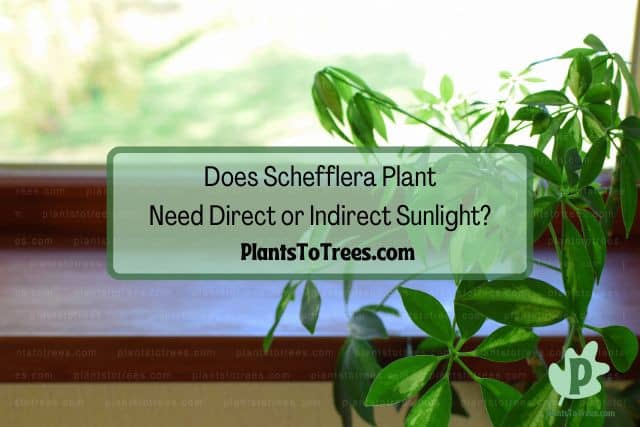
There are different levels of sunlight that plants require. While you may think that all plants can handle the same levels, you’ll soon find out that many plants will either be stunted or will die if placed in an area that has the wrong level of sunlight.
Schefflera plants do not do well in direct sunlight. They do best in bright to medium indirect sunlight. However, they are versatile and sturdy plants. They can also grow in low-light conditions. If you are growing them in a low-light setting, you will notice that they grow slower.
Is Schefflera Plant an Indoor Plant, Outdoor Plant, or Both?
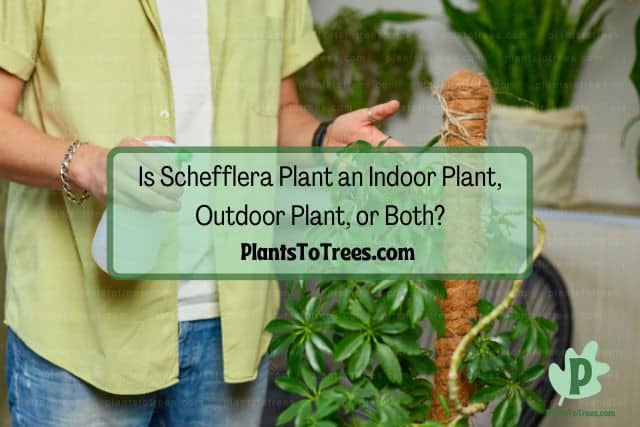
When it comes to successfully growing plants in and around your home, you want to select plants that can flourish in your particular environment. Some plants do well in both settings, while others are often suited to being specifically outdoor or indoor plants. Knowing what the ideal setting is to make your plants grow will prevent you from experiencing disappointment later when your hard work ends up with dead foliage.
The Schefflera plant can be both an indoor and outdoor plant. However, if you want to grow it outdoors, you need to live in the right climate. The Schefflera plant is a tropical plant. If you live in such a climate, your Schefflera plant will die.
The Schefflera plant is a very popular houseplant. They can flourish inside with little effort. They can also adjust to low levels of light.
What are the Lighting Requirements Indoors?
The Schefflera plant is a popular house plant because it is easy to care for and grow. It is also adaptable to the lighting that is available inside of your home.
The Schefflera plant does best in medium to bright indirect sunlight. It should never be placed in an area of direct sunlight. You can also place your Schefflera plant in areas that are low light. This will not harm the plant.
You may notice that in low light areas your Schefflera plant does not grow as quickly.
What are the Lighting Requirements Outdoors?
The Schefflera plant is a tropical plant that is found in forests. Most times when people hear ‘tropical’ they think of bright, sunny, humid areas. However, that is not always the case, there are plenty of tropical plants that do not do well in these conditions. It comes down to what environment they grow in.
The Schefflera plant when planted outdoors should be placed in an area that gets bright to medium in-direct sunlight. If you plant your Schefflera plant in an area with direct sunlight, you will notice that its growth is stunted.
This can also cause the plant to die, as too much direct sunlight can be harsh on the leaves and also accelerate the rate at which your plant begins to dry out.
What Soil Requirements Does Schefflera Plant Need?
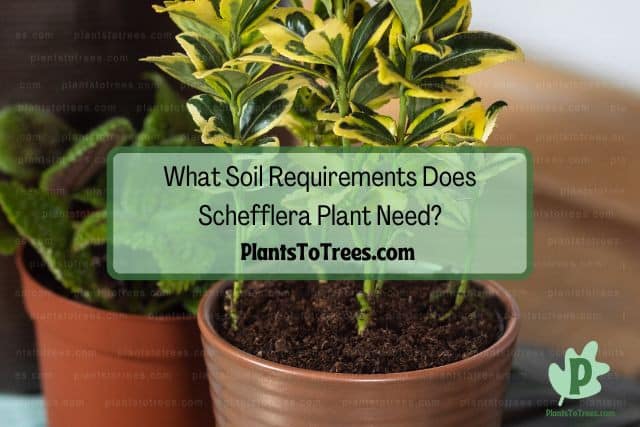
Soil plays a larger part in the growth of your plant than you may think. The soil will not only harness the nutrients for your plant to absorb through its roots, but it also provides proper drainage and moisture retention. Choosing the wrong soil for your plant can lead to many problems throughout the lifespan of your Schefflera plant.
The Schefflera plant needs a mixture of soil that is not too compact. You want your soil to be able to retain some moisture, but without becoming waterlogged. The ideal mixture of soil for the Schefflera plant is light potting soil mixed with rocks and peat moss.
The rocks, or you can use sand, go on the bottom of your pot and further increase the drainage capabilities of your Schefflera plant. You then want to top that with a light potting mix. You can look for one that offers low moisture. To top that you want to use some peat moss.
Peat moss is a great way to prevent your plant from drying out too much, but without retaining so much moisture you risk your plant becoming too saturated.
How Much Water Does Schefflera Plant Need?
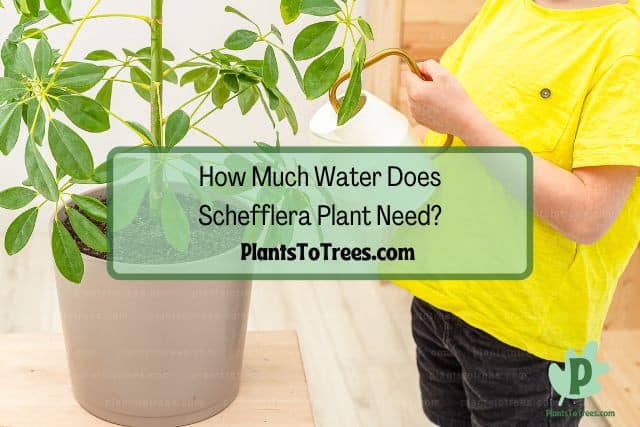
While the Schefflera plant is low maintenance and hardy plant, watering is an area where you can cause damage to your plant. Both overwatering and underwatering are harmful, and if you continue to do either, your Schefflera plant will eventually die. Starting out with the right watering schedule will set your Schefflera plant up for success.
The Schefflera plant does not like to be in a great deal of moisture at all times. While the plant likes slightly damp soil, allowing it to naturally dry out in between waterings will prevent it from being overwatered. You should water your Schefflera plant once every five to seven days.
When you water your Schefflera plant, make sure that the water drains out the bottom of your pot. If you’ve got a dish on the bottom, discard any remaining water. Leaving your plant in standing water will cause the soil to continue to suck up that moisture, and will not allow your plant to balance out.
Is My Schefflera Plant Overwatered? What are the Symptoms?
Oftentimes we don’t think about overwatering being an issue when it comes to plants. However, if the soil around your plant is not given the chance to dry out before being watered again, it can lead to serious problems such as root and stem rot, molding, and the attraction of insects.
You can tell if your Schefflera plant is overwatered by looking first at the leaves. If the leaves are brown, turning yellow, or have discolored spots on them, that is a good sign of overwatering.
While discoloration of the plant can also be an indicator of under watering, there are a few simple ways to determine which it is. Check the soil to see if it feels damp, while there should be some moisture in your soil, it should be beneath the surface. Depending on how long you’ve been overwatering your Schefflera plant, you may also notice the presence of mold on the top of your soil and at the base of your stem.
Your Schefflera plant will become weaker and the leaves will begin to fall off. As opposed to an underwatered plant, when you feel the stems or leaves they will feel rubbery and wilted.
To save an overwatered Schefflera plant, the first step is to stop watering it immediately. You want to give the soil a chance to dry out before you begin to water it again. When you do start watering it, start slow by giving your plant less water with longer intervals of watering in-between.
You should also check to make sure that your Schefflera plant is in a pot that has proper drainage holes. If your pot has clogged drainage, or you’ve selected the wrong soil, that backup of moisture will cause your plant to retain too much water.
Is my Schefflera Plant Underwatered? What are the Symptoms?
The Schefflera plant is natural to tropical forests. It flourishes in environments that are warm and humid. If your Schefflera plant is not getting enough water there are a few tell-tale signs that will alert you that you need to change your watering schedule.
If your Schefflera plant is underwatered, you will notice that it begins to droop. You may also notice that the leaves and stems change in color and become brittle to the touch. You can also tell by feeling the soil. While the top of your soil should be dry, the soil beneath the surface should have some moisture.
While the Schefflera plant is a rather sturdy plant, you shouldn’t make it a habit to under water it frequently. This will put stress on your plant and can lead to you killing it.
How Much Fertilizer Does Schefflera Plant Need?
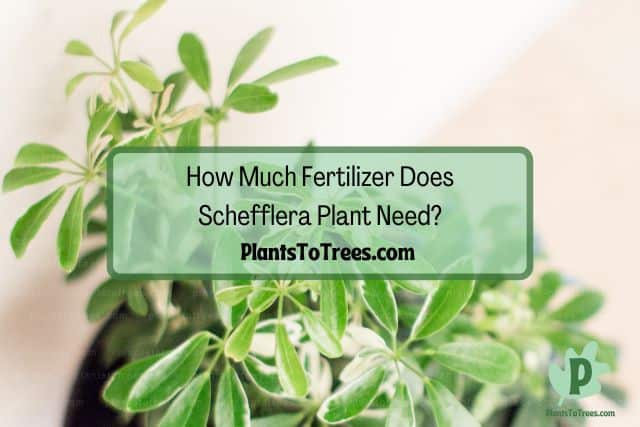
Fertilizing your plants, especially when you are growing them indoors, is essential if you want them to flourish. Fertilization provides much-needed nutrients that benefit the health and growth of your plants. When growing houseplants, the potting soil that you use may be lacking in certain nutrients that your plant would naturally absorb if it was growing in the wild.
You should fertilize your Schefflera plant every two to three weeks when your plant is in its growing season. This season runs from late spring through autumn. The ideal fertilizer to use is a liquid fertilizer. Use a 10-10-10 diluted liquid fertilizer.
However, one thing to keep in mind when using fertilizers is to not do it when your Schefflera plant is damaged. If your plant is recovering from overwatering, underwatering, or a recent pest infestation, hold off on the fertilizer application. If you don’t, you will cause further, and oftentimes, irreversible damage to your Schefflera plant.
Schefflera Plant Diseases to be Aware of
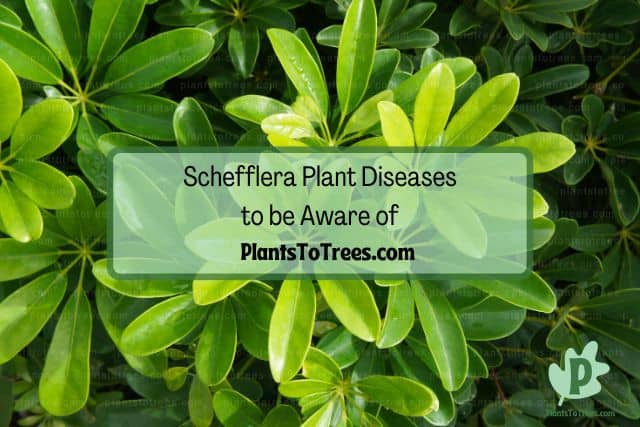
Some plants are more prone than others to suffer from diseases. These diseases can range from mild to serious. Some plant diseases can result in the death of your plant if they go untreated.
When grown as a houseplant, the Schefflera plant does not suffer from many diseases. However, if you over water your plant, or pot it in the wrong soil, you run the risk of the roots. If the soil is too saturated, your roots will essentially become waterlogged from absorbing too much moisture.
This leads your roots and stems to rot and begin to die. You may also notice the presence of mold on your soil and around the stem of your Schefflera plant stem. Your plant may also fall prey to mealybugs or mites. You typically see this with outdoor Schefflera plants. If you do not kill the pests, they can slowly work to kill your plant.
Are There Different Types of Schefflera Plant?
The majority of plants have different types within their same species. These differences can be subtle changes such as color, leaf shape, size, and appearance. Plants naturally develop different types when they are in different environments. To survive, the plant must make adjustments to continue growing. Other plants develop different types due to the creation of hybrids. Whether naturally, or from human intervention, hybrid plants are cross-pollinated and develop into an entirely new type.
There are between 600 and 900 different types of Schefflera plants that can be found across the world. These include smaller flowering plants, shrubs, and trees. The largest type can grow up to 65 feet tall. What connects all the types of Schefflera plants is their environment.
The Schefflera plant thrives in warm, humid environments.
How to Propagate Schefflera Plant
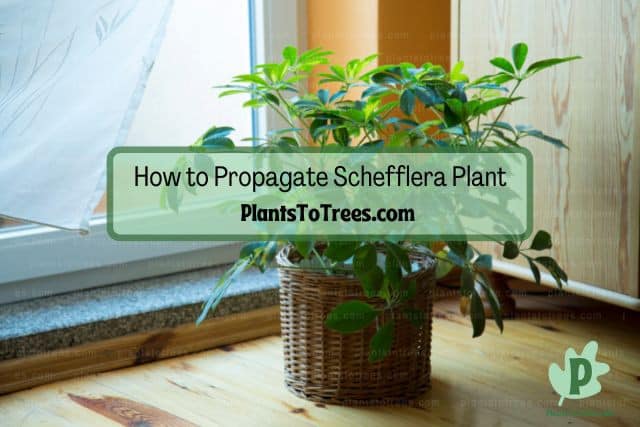
Propagation is the process in which you create new plants from parts of your mature plant. It’s a great way to continue to grow your collection of plants. Oftentimes, it is also a good way to ensure that your mature plant stays healthy as certain methods of propagation, such as separating or trimming, are necessary parts of care for your plant.
We at Plants To Trees first published this article on August 24, 2022. Copyright protected.
To propagate the Schefflera plant, you want to cut a part of the stem that has begun to develop new leaves. You want to cut just above the leaf node below it. Make sure not to cut too close to the leaf node, otherwise, that stem on your original plant will not continue to grow.
The Schefflera plant can be propagated in water, but it will take some time for roots to grow. If you want to propagate in water, fill up a glass or container with enough water to cover the bottom of your Schefflera plant trimming. Make sure that the water doesn’t reach too high on the stem, otherwise you risk stem rot. Make sure that your stem is supported and not leaning to the side. Put your plant in bright, but indirect sunlight. It needs a warm environment to grow successfully.
You can also propagate your Schefflera plant in soil. To do this the soil mixture itself is very important. You want to first fill your pot with rocks or sand. If you’re worried about the soil coming out of the bottom of the pot, rocks work best. Sand and rocks are great in the bottom of the pot because they help with water drainage. For the soil mixture, you want to mix potting soil and peat moss. You want something that will stay moist, without being over-saturated. Taking your Schefflera plant trimming, put it at least one inch into the soil. Make sure that your Schefflera plant trimming is upright, if necessary you can use a plant stake to keep it upright. If it leans at all, that’s the way that your roots will grow and your plant will be lopsided – or the strain may be too much and your plant will die. After you’ve put your trimming into the soil, put your pot in bright, but indirect sunlight in a warm area. Be sure to check the soil frequently, you want to ensure that it is getting enough moisture.
The Schefflera plant is a relatively easy plant to propagate. You can use both methods, but if you are looking for faster propagation, using soil is your best choice. Another way to speed up propagation is to cover your propagated plant with a plastic bag. What this does is it creates a humid and warm environment for your propagated plant, mirroring what the plant’s natural habitat is.
Is Schefflera Plant Toxic to Humans?
There are plenty of plants that we have in and around the homes that we may not know are toxic. Plants of the same species can also exhibit different levels of toxicity, ranging from mild irritation to being potentially fatal. If you have small children in your home it is especially important to do your research on the plants that you are selecting. Small children are curious and can end up touching or even eating your house and garden plants. Knowing the levels of toxicity in your plants can be the decision between making a trip to the emergency room or not.
The article owner is Plants To Trees dot Com and this article was first published on August 24, 2022.
The Schefflera plant is a toxic plant. The leaves of the plant have calcium oxidate crystals. When the leaves come in contact with the mouth or are ingested, it leads to painful swelling, as the spine-like crystals in the leaves attack the soft tissue.
There are different levels of toxicity when it comes to the Schefflera plant. While some types of the plant can cause the airway to begin to close up due to swelling and irritation, there are other types that, when ingested, can lead to kidney failure.
If your child has ingested your Schefflera plant, you should seek medical attention right away. Some of the symptoms include nausea, vomiting, diarrhea, swelling of the mouth and lips, trouble when speaking, excessive drooling, and dilated pupils.
Is Schefflera Plant Toxic to Dogs?
If you’re a dog owner, you know that dogs like to investigate things in their surroundings. This includes your house and garden plants. While some dogs will simply dig up plants, others may eat your plants as well. If you have a dog, knowing what plants are toxic is important, this way you can either put your plants in an area where your dog can’t reach them or not get them at all. Understanding the signs and level of toxicity in your plants is important, this way you know if your dog has ingested the plant when you’re not looking, and if it requires a visit to the veterinarian.
The Schefflera plant is toxic to dogs. This is because the Schefflera plant has calcium oxalate crystals, and in some varieties, proteolytic enzymes in its leaves. The oxalate crystals are spiny and found in the leaves of the plant.
If your dog chews on or ingests the plant, these crystals will pierce the mouth, leading to pain, irritation, and swelling. What makes them dangerous is that they can lead to the airway closing up. The proteolytic enzymes also lead to further inflammation. If your dog has ingested or had Schefflera plant in its mouth, you should seek veterinary attention.
As we can’t always watch our dogs, there are a few symptoms to look out for if you know that you have Schefflera plant in or outside of your home. Your dog may exhibit excessive drooling, trouble breathing and barking, pawing at their face or mouth, swelling of the lips and mouth, vomiting, diarrhea, and disorientation. If you notice any of these symptoms, you should take your dog to the veterinarian immediately.
Is Schefflera Plant Toxic to Cats?
Cats are curious creatures. They also have a habit of getting into and destroying things around their home that they shouldn’t. This includes house plants. What makes it difficult in keeping your cats away from your houseplants, is unlike dogs, cats will jump up on surfaces as they please. Keeping plants away from your cat might need some careful planning, especially if you have a plant that is toxic.
The Schefflera plant is toxic to cats. The presence of both calcium oxalate crystals, and in some varieties, proteolytic enzymes will cause irritation and inflammation. If your cat ingests the Schefflera plant, it can even lead to kidney failure.
If you have Schefflera plants in or around your house, it is important to know the symptoms of Schefflera plant ingestion. If your cat has chewed on or ingested it, you will want to contact your veterinarian right away.
Some of the most common indicators that your cat has chewed on or ingested the Schefflera plant are excessive drooling, swelling of the lips or mouth, pawing at their mouth, difficulty breathing, wheezing, seeming disoriented, vomiting, and diarrhea. If you notice any of these symptoms and you have plants around your house, you should take your cat to the veterinarian right away.
Related Articles
Chinese Evergreen Plant Care Guide
PlantsToTrees.com is the owner of this article and we first published this on August 24, 2022.
